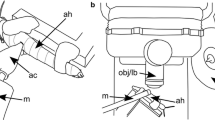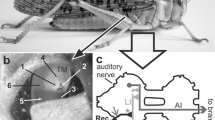Summary
The mechanical transmission of sound in the tympanal organ of adults and 5th instar larvae ofLocusta migratoria andSchistocerca gregaria has been investigated by means of stroboscopic measurements within a frequency range from 1–20 kHz.
Frequency dependent spatial distributions of amplitudes and phases of oscillation on the tympanal membrane and the Müller's organ could be demonstrated. Cuticular structures on the membrane may act as a lever arm (e.g. elevated process) and cause a transformation of the (unidimensional) membrane motion into components of displacements in the Müller's organ perpendicular, as well as even parallel, to the membrane.
Sites of maximum relative displacements at distinct frequencies are found to be correlated to the course of the dendrites of the acoustic receptor cells. Differences in morphology of the tympanal organ between the two species as well as between adults and larvae always correspond to differences in the mechanical properties (resonances etc.). Consequently, differences or changes in the neurophysiological response characteristics of the different receptor cells have been found.
Based upon these findings a correlation between the anatomical and physiological classification of the receptor cell groups is presented.
Similar content being viewed by others
Abbreviations
- T1, T2, T3, T6, T7 :
-
reference points on the tympanal membrane
- M1, M4 :
-
reference points on the ganglion of the Müller's organ
- K1, K2 :
-
reference points on the elevated process
References
Autrum H (1963) Anatomy and physiology of sound receptors in invertebrates. In: Busnel RG (ed) Acoustic behaviour of animals. Elsevier, Amsterdam, pp 412–433
Békésy G von (1953) Description of some mechanical properties of the organ of Corti. J Acoust Soc Am 25:770–785
Breckow J, Kalmring K, Eckhorn R (1982) Multichannel-recordings and real-time Current Source Density (CSD) analysis in the central nervous system of insects. Problems and methods of application. Biol Cybern 45:115–121
Dragsten PR, Webb WW, Paton JA, Capranica RR (1974) Auditory membrane vibrations: Measurement at sub-Angstrom levels by optical heterodyne spectroscopy. Science 185:55–57
Drake AD, Leiner DC (1984) A fiber Fizeau interferometer for measuring minute biological displacements. IEEE Trans Biomed Eng 31 (7): 507–511
Fletcher NH, Thwaites S (1979) Acoustical analysis of the auditory system of the cricketTeleogryllus commodus (Walker). J Acoust Soc Am 66 (2): 350–357
Gray EG (1960) The fine structure of the insect ear. Philos Trans R Soc London Ser B 243:75–94
Hill KG (1983a) The physiology of locust auditory receptors. I. Discrete depolarisations of receptor cells. J Comp Physiol 152:475–482
Hill KG (1983b) The physiology of locust auditory receptors. II. Membrane potentials associated with the response of the receptor cell. J Comp Physiol 152:483–493
Johnstone BM, Saunders JC, Johnstone JR (1970a) Tympanic membrane response in the cricket. Nature 227:625–626
Johnstone BM, Taylor KJ, Boyle AJ (1970b) Mechanics of the Guinea Pig cochlea. J Acoust Soc Am 47:504–509
Kalmring K (1975) The afferent auditory pathway in the ventral cord ofLocusta migratoria (Acrididae). I. Synaptic connectivity and information processing among the auditory neurons of the ventral cord. J Comp Physiol 104:103–141
Keuper A (1984) Die Untersuchungen von multimodalen Konvergenzen und sensomotorischen Übergängen im ZNS vonLocusta migratoria; Mehrkanalableitungen und Stromquellendichte-Methode. Dissertation, Marburg
Lewis DB (1974) The physiology of the tettigoniid ear. I.–III. J Exp Biol 60:821–859
Michel K, Petersen M (1982) Development of the tympanal organ in larvae of the migratory locust (Locusta migratoria). Cell Tissue Res 222:667–676
Michelsen A (1971a) The physiology of the locust ear. I. Frequency sensitivity of single cells in the isolated ear. Z Vergl Physiol 71:49–62
Michelsen A (1971b) The physiology of the locust ear. II. Frequency discrimination based upon resonances in the tympanum. Z Vergl Physiol 71:63–101
Michelsen A (1971c) The physiology of the locust ear. III. Acoustical properties of the intact ear. Z Vergl Physiol 71:102–128
Michelsen A (1973) The mechanics of the locust ear: An invertebrate frequency analyzer. In: Möller AR (ed) Basic mechanisms of hearing. Academic Press, New York
Michelsen A (1979) Insect ears as mechanical systems. Am Sci 67:696–706
Michelsen A, Larsen ON (1978) Biophysics of the ensiferan ear. I. Tympanal vibrations in bushcrickets (Tettigoniidae) studied with Laser vibrometry. J Comp Physiol 123:193–203
Morse PM (1948) Vibration and sound. McGraw-Hill, New York
Paton JA, Capranica RR, Dragsten PR, Webb WW (1977) Physical basis for auditory frequency analysis in field crickets (Gryllidae). J Comp Physiol 119:221–240
Petersen M (1982) Aufbau und Funktion der Hör- und Vibrationsbahn bei Larven der WanderheuschreckeLocusta migratoria. Dissertation Marburg
Petersen M, Kalmring K, Cokl A (1982) The auditory system in larvae of the migratory locust. Physiol Entomol 7:43–54
Rehbein HG (1976) Auditory neurons in the ventral cord of the locust: morphological and functional properties. J Comp Physiol 110:233–250
Römer H (1976) Die Informationsverarbeitung tympanaler Rezeptorelemente vonLocusta migratoria (Acrididae, Orthoptera). J Comp Physiol 109:101–122
Schiolten P, Larsen ON, Michelsen A (1981) Mechanical time resolution in some insect ears. I. Impulse responses and time constants. J Comp Physiol 143:289–295
Schwabe J (1906) Beiträge zur Morphologie und Histologie der tympanalen Sinnesapparate der Orthopteren. Zoologica 20:1–154
Seymour C, Lewis B, Larsen ON, Michelsen A (1978) Biophysics of the ensiferan ear. II. The steady-state gain of the hearing trumpet in bushcrickets. J Comp Physiol 123:205–216
Sippel M, Breckow J (1983) Non-linear analysis of the transmission of signals in the auditory system of the migratory locustLocusta migratoria. Biol Cybern 46:197–205
Sippel M, Breckow J (1984) Non-monotonic response intensity characteristics of acoustic receptor cells ofLocusta migratoria. J Comp Physiol A 155:633–638
Skudrzyk E (1971) The foundation of acoustics. Springer, Wien New York
Stephen RO, Bennet-Clark HC (1982) The anatomical and mechanical basis of stimulation and frequency analysis in the locust ear. J Exp Biol 99:279–314
Author information
Authors and Affiliations
Rights and permissions
About this article
Cite this article
Breckow, J., Sippel, M. Mechanics of the transduction of sound in the tympanal organ of adults and larvae of locusts. J. Comp. Physiol. 157, 619–629 (1985). https://doi.org/10.1007/BF01351356
Accepted:
Issue Date:
DOI: https://doi.org/10.1007/BF01351356




